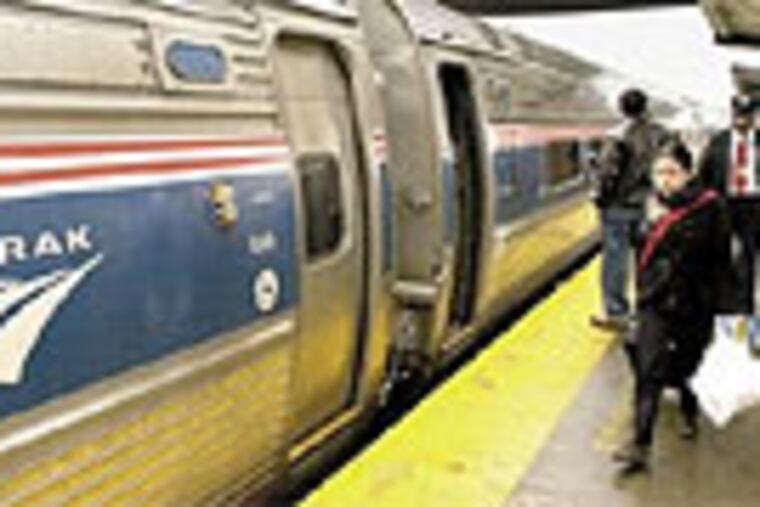Looming fund cuts endanger Amtrak's Keystone line
The popular Keystone rail service between Philadelphia and Harrisburg, Amtrak's fourth-busiest route, could face serious cutbacks next year because of reduced federal subsidies.

The popular Keystone rail service between Philadelphia and Harrisburg, Amtrak's fourth-busiest route, could face serious cutbacks next year because of reduced federal subsidies.
Amtrak will end its $8 million-a-year contribution for running the service on Oct. 1, 2013, to comply with a 2008 law that requires Amtrak to shift operating costs to the states, Amtrak spokeswoman Danelle Hunter said.
Pennsylvania, which already spends about $9 million a year to underwrite Keystone operations, has its own financial woes and is negotiating with Amtrak to avoid service cuts.
A similar fate faces the Pennsylvanian service, the once-a-day diesel passenger train that operates between Harrisburg and Pittsburgh. Pennsylvania does not contribute to the costs of operating that train, which gets a $7 million annual subsidy from Amtrak.
"Pennsylvania will be required to pay for both the Keystone service and the Pennsylvanian," Hunter said. "Amtrak will continue to make significant contributions to the upkeep and maintenance of the infrastructure."
Ridership on the Keystone route has doubled since 2000, to more than 1.3 million passengers a year, as Amtrak and the state and federal governments have put millions of dollars into improving the Amtrak-owned line.
In 2006, a $145 million upgrade to the 104-mile corridor was completed, providing faster service and more frequent trains. The federal Department of Transportation gave Pennsylvania $40 million last year to rebuild a rail intersection near Harrisburg to reduce travel time and improve reliability on the Keystone corridor.
And next year, Amtrak is scheduled to put new locomotives in service on the Keystone line that will allow 125-m.p.h. travel, faster than on any route except the Northeast Corridor between Washington and Boston.
"Ridership is good, the infrastructure is good, and customers are responding," said Matthew Mitchell of the Delaware Valley Association of Rail Passengers. "It's cost-competitive and time-competitive with driving."
Tickets sell for as little as $26 each way, and express trains make the trip in 95 minutes.
Amtrak currently operates 14 daily trips in each direction.
Passengers now pay for about 73 percent of the cost of Keystone operations.
For the first nine months of this fiscal year, ticket revenue was $27.5 million, while operating costs were $37.8 million. Revenues for the period were up 11 percent from the same period a year earlier, with ridership up 5 percent.
Subsidies from Pennsylvania and Amtrak have been declining gradually as ridership and ticket revenue have risen.
But Pennsylvania is not likely to replace the full $8 million subsidy from Amtrak, leaving severe cuts in service as "a distinct possibility," said Andy Sharpe, communications director of the rail passengers association.
"Given the unwillingness of Gov. Corbett to address the lack of dedicated funding for local and regional mass transit, we are skeptical that he'd be willing to provide a boost in funding to maintain current service levels on the Keystone," Sharpe said.
Another possibility would be for Pennsylvania to contract with another rail operator, such as SEPTA or a private firm like Herzog Transit Services Inc. of St. Joseph, Mo., to run the trains.
"It might put more of the onus on PennDot to start looking around for a competitive bidder," said Mitchell. "Amtrak's unit operating costs are relatively high."
PennDot press secretary Steve Chizmar said it's too soon to say what will happen to the Keystone service.
"We want to get this resolved," Chizmar said. "It's a crucial link . . . a vital route."
PennDot and Amtrak officials are discussing ways to share the subsidy without running afoul of the 2008 federal law.
That law, the Passenger Rail Investment and Improvement Act, includes a section that requires Amtrak to standardize subsidies for routes of less than 750 miles outside the Northeast Corridor.
"Amtrak is in the business of running trains, and we want to continue to run all the corridor services we operate today," said Hunter. "We have been and are continuing to work with PennDot and other states to determine how best to comply with this federal law."